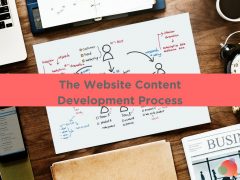 A few years ago, we had a client who launched a new website.
A few years ago, we had a client who launched a new website.
As part of their launch process, we helped them find the firm that would build the site for them.
We were extremely happy when they chose Orbit Media Studios.
We knew they’d do a great job for our client, and make us look good for recommending them.
The challenge for us came after they hired Orbit—they asked to put our work on hold while they focused on building the site.
We were doing content creation and blogging and lead generation—all things that cannot be put on hold especially when you’re building a new site.
A website needs content, after all.
But they thought it was too much to handle at once.
So Andy Crestodina and I sat down with them to discuss what Orbit does compared to what we do to show them how they really needed to be doing both.
Following is the website content development process we created during that meeting. I hope it’s helpful for you, too.
The Website Process
There are many things Orbit—and other web design firms—focus on:
- Visual standards
- Sitemap
- Wireframes
- Moodboards
- Design
- Development
- Testing
- Launch
Then there are things we do together:
- Strategy and branding
- Review of the mission, vision, and values
- Research of audience needs, marketing size, and a competitive analysis
- Position
- Messaging
- Keyword research
Once those things are complete and, as the site is being developed, content has to be created.
Most organizations have some of the content already developed, some can transfer from the existing site, and some of it has to be created.
Content Development Process
Here is the content development process we use.
- Content assessment. Dig into the analytics and determine which pages on the current site have the most unique pageviews. Which have the most social shares? The most comments? Answering these questions—and letting analytics be your guide—helps you determine which pages should transfer and which can die with the existing site. It drives the content strategy.
- Content marketing strategy. Using the information discovered during the messaging and keyword research phases, as well as the content assessment, a content marketing strategy must be completed. What is your editorial mission? What do you want to accomplish? Which stories will you tell? How will you tell them? Which mediums will you use? When do you need subject matter experts? Who will author certain pieces? What are the goals? How will you measure results?
- Develop content. Now it’s time to develop content. You put the editorial mission on paper, on video, and/or on audio. Tell the company’s story, from the perspective of the customer. Build the evidence. Create content for the keywords you’ve researched and prioritized. Create content that doesn’t yet exist. Format and build links. Optimize the pages with title tags, ALT text, meta descriptions, and rich snippets.
- Edit. You cannot edit your own work when a website is coming together. There must be a process for at least two, if not three, other people to review what you’ve created. Have someone read the content out loud. Have another person watch the video. And have yet someone else listen to the audio. Lots of mistakes will be found that way. Have an AP style expert take the next round. Then have a final review by a decision maker.
- Enter content. Now it’s time to enter all of the content. Most web firms will provide you access to the development site so you can enter—and optimize—what you’ve created. Others will do it for you. No matter the process, this is when you’ll discover what text, images, and videos you’re still missing and how what you have looks in the new design. You also will find places you have to shorten content or make things a little more zippy.
- Rinse and dry. You may have to start with step three again, depending on if you’re missing anything once content gets uploaded. Then it’ll be time to pass it back over to the web firm to test and launch.
As Andy put it, they build the race car and we drive it.
Is your race car ready to drive?